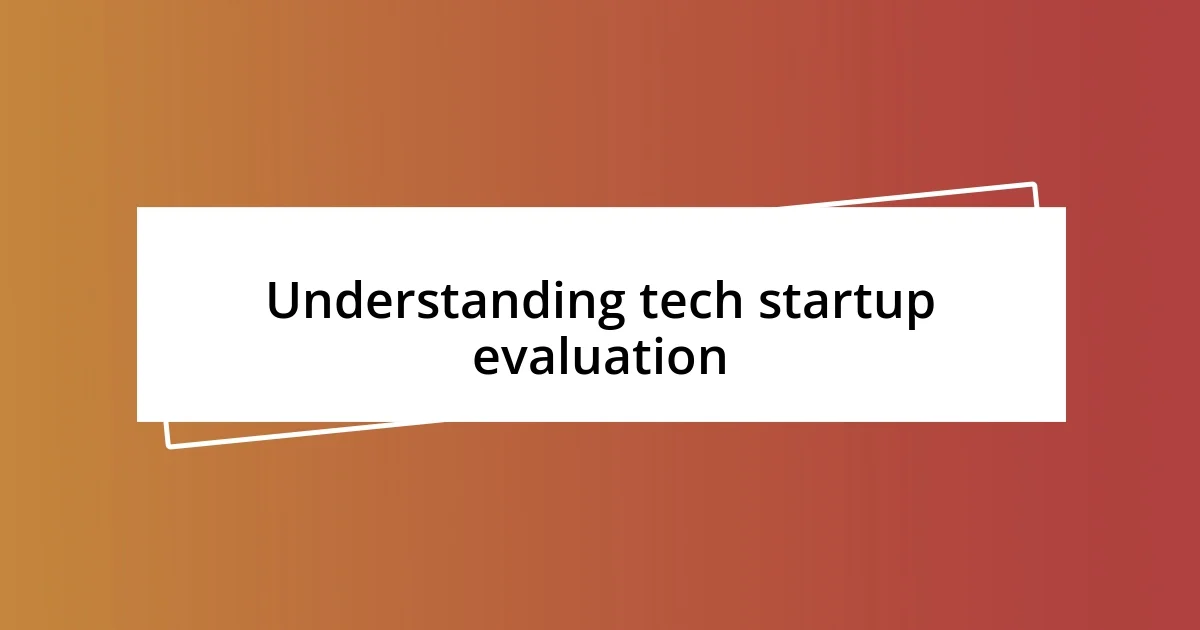Key takeaways:
- Understanding the technology and evaluating the startup team are crucial for assessing a startup’s potential, as both factors significantly influence its success.
- Identifying real problem statements through thorough research and user interviews is essential to develop effective solutions that resonate with target audiences.
- Conducting user feedback analysis can uncover vital insights for product improvement and innovation, highlighting the importance of listening to user sentiments beyond mere metrics.

Understanding tech startup evaluation
When I think about evaluating tech startups, it becomes evident that understanding the underlying technology is crucial. Have you ever tried to assess a product you knew little about? It’s like deciphering a foreign language. I remember my first experience evaluating a software startup, where I had to grasp the complexities of their unique algorithm. It was challenging, yet it taught me how vital it is to dig deep into the tech to understand its potential impact and sustainability.
Beyond just the technology itself, I find that the team behind a startup holds immense value. The enthusiasm and capability of the founders can make or break a venture. I once met a passionate duo whose vision was as compelling as their product, and their drive was infectious. It reminded me that evaluating a startup isn’t solely about numbers; it’s also about the people who breathe life into the idea.
Finally, metrics and market potential can’t be overlooked. When I evaluate, I often ask myself: “Is there a real need for this solution?” One time, I disregarded a startup because their growth metrics seemed inflated, only to see them pivot successfully to a more pressing market demand later on. This experience reinforced for me the importance of not just looking at the data, but also understanding the market dynamics that can affect a startup’s journey.

Identifying key problem statements
Identifying key problem statements is fundamental when evaluating tech startups. I’ve often seen startups that rush to develop a solution without accurately identifying the problem they intend to solve. In one instance, I encountered a team that built a complex platform meant to streamline communication. However, it swiftly became apparent that their target users were facing entirely different challenges, such as managing time effectively. This taught me the importance of conducting thorough research to pinpoint the real pain points.
When I think about key problem statements, I reflect on my own challenges in differentiating noise from valuable feedback. There was a time when I was consulting for a startup that launched a product based on the loudest complaints they heard, rather than the most pressing issues. This not only led to wasted resources but also confusion among their potential users. It illuminated the need for prioritizing problems that genuinely hinder users, rather than those that just happen to attract attention.
In evaluating any tech startup, I turn my attention to how the problem statements resonate with real-world experiences. I remember guiding a team that created a financial app aimed at college students. They believed the key problem was budgeting, but through user interviews, we discovered that students were more concerned about understanding their loans. This shift in understanding shaped their development strategy and ultimately led to a more impactful solution.
| Key Problem Statement | Impact on Solution |
|---|---|
| Understanding User Pain Points | Directs development towards real issues |
| Listening to Feedback vs. Noise | Affects resource allocation and focus |
| Resonating with Real Experiences | Shapes effective and relevant features |

Assessing product market fit
Assessing product market fit is a nuanced process that goes beyond simply validating a product’s existence in the market. I recall a time when I helped a startup that had developed a cutting-edge app to improve productivity. They were excited by the initial downloads, but as we dug deeper, it became clear that users weren’t sticking around. Through careful analysis, we realized the app lacked essential features that truly aligned with user needs. This experience taught me that understanding how well a product meets the desires of its target audience is vital to achieving sustainable growth.
When evaluating product market fit, I rely on a few key indicators that often reveal the underlying truth of a startup’s potential success. I’ve learned to look for:
- User Engagement: Are users actively engaging with the product on a daily or weekly basis?
- Customer Feedback: What do users say? Are they expressing genuine excitement or frustration?
- Retention Rates: How many users return after their first experience? A low retention rate can be a red flag.
- Market Demand: Is there a growing interest in the type of solution being offered? Tracking trends can provide valuable insights.
- NPS (Net Promoter Score): This metric can indicate how likely users are to recommend the product to others, which is a strong sign of fit.
By analyzing these indicators, I continually refine my understanding of a startup’s product-market alignment, adjusting assessments based on real-world user behaviors. Each startup is a unique story, and I find that the journey to product-market fit is as much about understanding those stories as it is about the data.

Evaluating technology feasibility
Evaluating technology feasibility requires a deep dive into the functional aspects of a solution. I remember a tech startup that was passionate about their AI-driven chatbot product. The excitement was palpable, but upon examining the underlying technology, it became clear there were significant limitations in their data processing capabilities. How could they expect the chatbot to provide meaningful interactions if it couldn’t properly understand user intents? This experience reinforced my belief that a thorough technical assessment is vital before moving forward with a solution.
It’s essential to ask not just if a technology works but also if it can scale effectively. In one project, I worked with a team developing a cloud-based service. Initially, their testing showed promise, but we realized the platform could crash under heavy use. The stress testing we conducted revealed flaws that could have spelled disaster if they’d launched prematurely. This highlighted the importance of robust testing and validation against potential real-world scenarios.
When evaluating feasibility, I also consider integration with existing systems. I once consulted for a startup intent on developing a healthcare application. While their technology was innovative, there was a glaring issue: it had no way to seamlessly connect with current health records systems. Reflecting on that moment, I thought about users who would be left wrestling with fragmented data. It’s moments like these that emphasize the need for solutions to harmonize with the broader technological landscape; otherwise, the potential for real impact may just fade away.

Analyzing competitive landscape
When I look at the competitive landscape, I often find it’s like peering into a chess game—every move counts. I remember working with a startup that was eager to launch its innovative product without first investigating its competition. A quick market analysis revealed a rival offering a similar solution but with a more established user base and better branding. It hit me then how essential it is to assess not just the competitors’ features but their overall strategies and market positioning. It’s not enough to be unique; you must understand how you fit into an already crowded space.
In my experience, examining competitor strengths and weaknesses can unveil unexpected opportunities. I once helped a tech startup that offered a unique service but discovered that their direct competitors were losing ground due to poor customer support. This insight prompted us to enhance their support strategy, giving them a sharp competitive advantage. By aligning the product with the needs of underserved market segments, we turned a vulnerability into a strength. Isn’t it fascinating how awareness of the competitive landscape can shape a startup’s identity and strategy?
I also believe that following emerging trends within the competitive landscape is crucial. In one consultation, I spotted a rising trend towards sustainability in tech solutions. While many established players stuck to traditional approaches, the startup I was advising quickly pivoted to incorporate eco-friendly practices into their service. This not only distinguished them from competitors but resonated deeply with consumers who valued sustainability. I often wonder if businesses realize how a proactive understanding of competition can not only safeguard their relevance but also ignite innovation. Wouldn’t you agree that staying ahead of the curve can be a game changer?

Reviewing business model sustainability
Evaluating a startup’s business model for sustainability means delving into how it generates revenue consistently. I recall a fintech startup that had a brilliant idea but relied heavily on one-time sales without a recurring revenue stream. I couldn’t help but wonder, would they be able to survive if customer demand fluctuated? That experience really drove home the point for me: a vibrant business model should include diverse revenue sources that can weather market shifts.
Moreover, I often assess the startup’s value proposition to its customers. Early in my career, I evaluated a SaaS company whose model revolved around high up-front fees but lacked ongoing value for users. Reflecting on that, how can a business expect loyalty if it doesn’t continually invest in its customers? This realization led us to rethink their offering, incorporate features that provided ongoing benefits, and foster stronger customer relationships.
Lastly, I’m always on the lookout for scalability in their business model. I once consulted with a subscription box service that had exceeded its initial subscriber goals but had no plan for growth. I couldn’t shake the thought: what happens when you hit the ceiling? We worked together to develop a tiered subscription approach, allowing for a wider audience and enhanced customer engagement. It’s moments like these that truly verify to me the importance of building a model that isn’t just successful today, but can thrive in the future.

Conducting user feedback analysis
When I conduct user feedback analysis, I approach it as both an art and a science. I think back to a mobile app I evaluated, which was designed for fitness tracking. They assumed users loved the interface based solely on download numbers. However, after collecting user feedback, we learned that many found the navigation cumbersome. Reflecting on this, isn’t it amazing how a few thoughtful surveys can uncover what users truly feel, changing the course of product development?
In my interactions, I’ve learned the power of qualitative feedback. During a project with an e-commerce startup, we hosted user interviews to delve deeper into customer experiences. Their complaints about a checkout process that felt overly complicated opened my eyes; we quickly pivoted to streamline it based on direct user insights. What I found most compelling was how users appreciated our willingness to listen—and that connection built loyalty. It makes me ponder: how often do businesses miss out on vital user sentiments because they stick to mere numbers?
Analyzing user feedback isn’t just about identifying problems—it’s about finding opportunities for growth. A personal experience with a software company comes to mind; after running a feedback campaign, users expressed desire for collaborative features. This insight ignited our discussions, leading to the creation of tools users didn’t even know they were missing. It’s so rewarding to witness how incorporating user-driven changes fosters innovation. Have you ever considered how a simple shift in focus from features to user experiences can open doors to possibilities no one anticipated?














